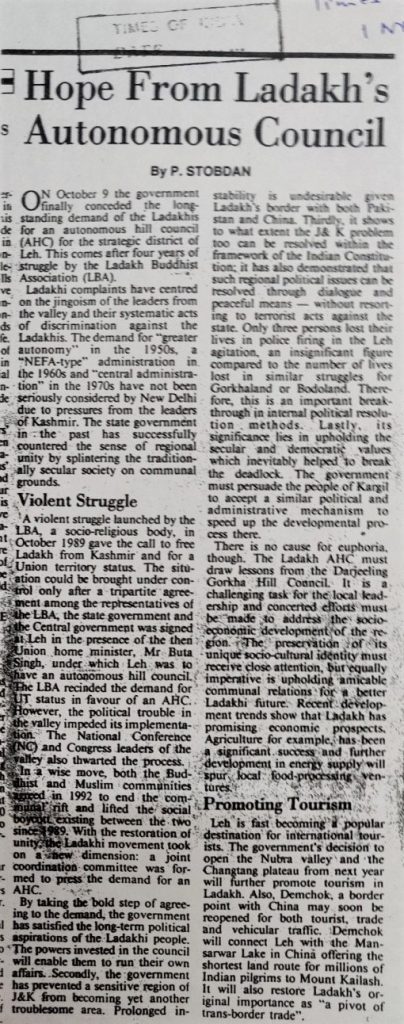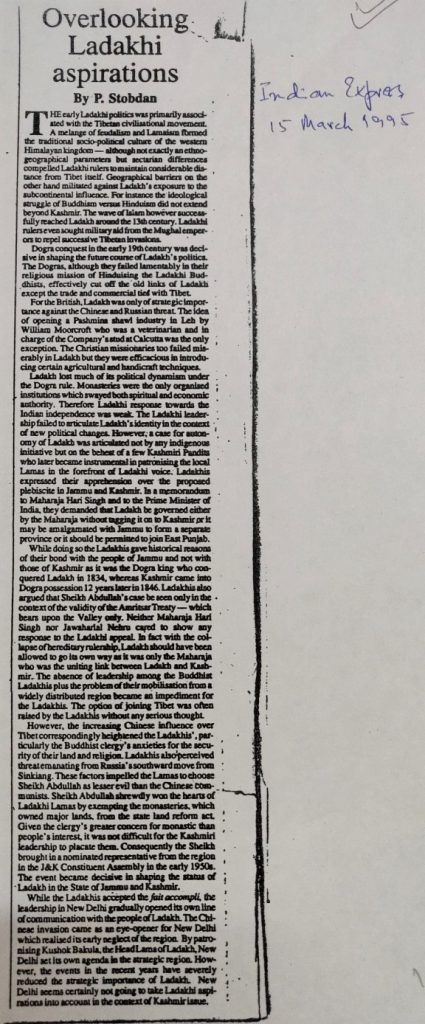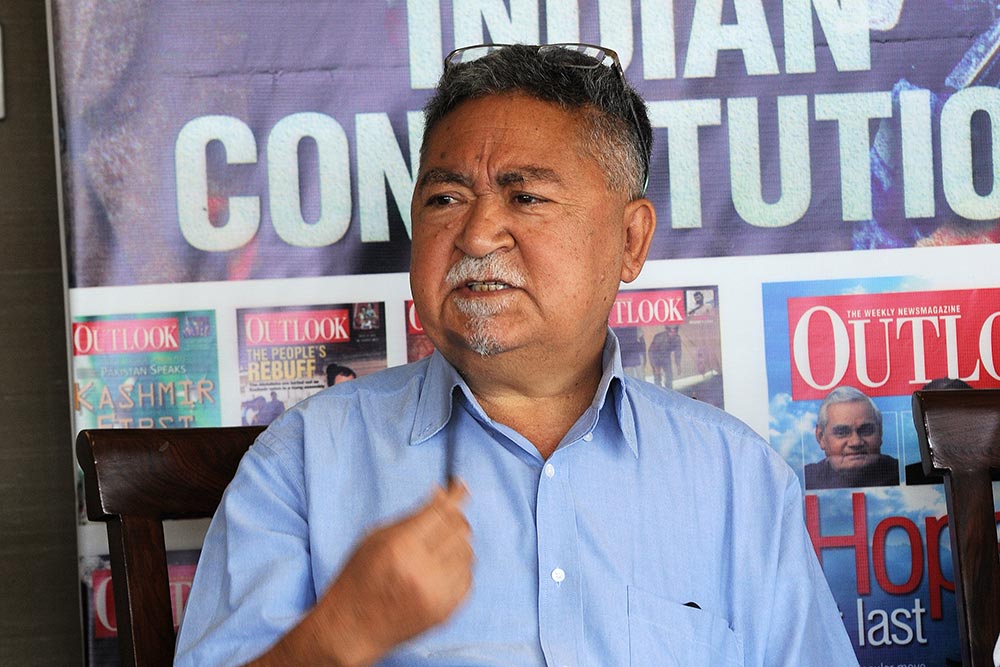It is easy to undermine someone. However, it is important that our perspective is informed by facts. In this regard, I must admit that I neither have the expertise to judge P. Stobdan’s skill as a scholar of diplomacy nor can I claim to be a part of the legions of fans who idolise him.
Like many others, I was struck by his comments on Aaj Tak. I was equally struck by the response his comments generated, including a massive outcry in Ladakh and in Tibetan communities elsewhere. Keeping aside the televised debate and his comments, I started to wonder about the depth of the angst being expressed on an individual’s views on issues of national security and border conflict. Therefore, I will focus on the manner in which we responded as a society rather than his comments.
P. Stobdan is known for putting forward his point of view in a forthright manner be it in a public forum or in government circles. In this he has remained consistent in his line of thinking and the manner in which he expresses himself. He is a policy analyst and a fairly well-known strategic thinker who has his share of admirers and critics at the local, national and international level.
I do wonder how we as a society, which has at best a limited understanding of wider geopolitical issues, can so easily dismiss his views in such a bigoted manner. It raises some certain serious questions about us a society. We need to put things in proper perspective or else we will not grow into a progressive society. I must admit that our future in this regard does look rather dark at the moment. Since I am raising this issue, I will add that we must look at P. Stobdan’s contributions to Ladakh over the last four decades to get a sense of perspective and context to his place in Ladakhi society.
In this regard, I was particularly disturbed by an opinion piece in Phayul written by a Tibetan doctoral scholar. In his reponse to P. Stobdan’s statement on the Sino-Indian border tension in Ladakh, Tibetan scholar Darig Thokmay, who is pursuing his doctoral research at Oxford University, wrote this opinion piece titled, ‘Phunchok Stobdan is a Fake Expert on Himalayan Geopolitics’. The title itself indicates that this not an academic rebuttal but an effort to publically shame someone. In this piece, Darig Thokmay seems to have adopted a piecemeal approach and distorted facts without engaging with the core argument made by P. Stobdan on the silence of the Tibetan Government-in-exile on the boundary dispute between India and China.
In the same article, Darig Thokmay has denied that a ceremony was held to raise the Tibetan flag near Pangong-Tso in Ladakh that was attended by the president of the Central Tibetan Administration in Dharamsala, Dr. Lobsang Sangay. The fact remains that Dr Lobsang Sangay has been photographed with the Tibetan flag on 5 July 2017 along the banks of Pangong-Tso, which was reported by various media outlets.
I checked public records and can confidently state that P. Stobdan has never uttered a remark on Ladakh that would harm its interest in anyway. If nothing else, he must be given credit for initiating a discourse that includes the Tibetan community. It is interesting that after P. Stobdan’s statement, Dr Lobsang Songay of the Tibetan Government-in-exile did make a public statement that “Ladakh and Tawang have always been a part of India”. This is perhaps the argument that P. Stobdan has been reiterating throughout in his academic engagement on the subject.
Even if one were to disregard P. Stobdan’s expertise in geopolitics of the region and four decades of scholarship, I was disturbed by the blatant attack on intellectuals that sets a new precedent in our society and our claim of being liberal. P. Stobdan has apologised for his comments. However, this did not stop people from launching personal attacks on him. Public anger was expressed through the observance of a one-day strike on 1 June and the burning of his effigy. Sadly, such performative street politics failed to engage with the complex problems embedded in the region as a political entity. Such display of misplaced collective restlessness suggest that we remain politically immature as a society. In fact, we managed to achieve nothing through such actions.
Yet, its fallout will be far-reaching. This sort of reaction is not conducive to dialogues necessary for peaceful coexistence based on fundamental acceptance of differences of opinion. I must reiterate that I am not focusing on the content of P. Stobdan’s comment but on our collective response to it. In my opinion, we should have engaged our energies in trying to understand and deal with the complexity of issues that surround Ladakh as a political entity. Ladakh is grappling with enough challenges and does not need us to add to them.
One of the criticisms leveled against P. Stobdan was that he has not contributed anything to the progress of Ladakh. I am not qualified to list who has helped to build Ladakhi society and judge their contributions. Moreover, I am not interested in engaging in mudslinging especially with various vested political interests.
Despite my personal limitations, I feel the need to sketch out P. Stobdan’s pursuits in strategic thinking and his engagement in regional and world politics. As I researched his work, I realised that his contribution to shape regional politics has been myriad and immense. His intellectual engagements probably do not fit easily in a relatively closed society like ours. I am of the firm belief that intellectual engagements are an outcome of consistent and committed negotiations with the world of politics. We need to cultivate such traits and find a more constructive role for intellectuals in our society.
P. Stobdan’s contribution to Ladakh
I have looked through various archives and online databases to piece together at least some of P. Stobdan’s works. Though P. Stobdan has never served as an elected representative for Ladakh, he has channeled much of his intellectual energy to voice Ladakh’s aspirations in the national political scene.
We should also remind ourselves that holding academic and diplomatic positions in institutions of independent India do have indirect benefits to local communities. It is a matter of fact that P. Stobdan does not live in Ladakh and visits his hometown only occasionally. To me, he is one of the cosmopolitan figures living in the national capital of New Delhi and operates at a different level from the rest of us. He enjoys vast experience and exposure for which he is known widely in the country and outside. It is quite natural that P. Stobdan’s non-ethnocentric thought-process is problematic to those who are singularly engaged in various emotionally-charged pursuits. This pattern is evident around the world and Ladakh is no exception.
Remember P. Stobdan has been under no obligation to speak for Ladakh. Despite this, he has always made time to voice issues of importance for Ladakh. Time and again since the late 1980s, he has managed to draw national attention to such issues irrespective of the risks this has posed to his primary vocation as an academic and professional diplomat. There was a time when Ladakh didn’t have anyone to articulate its case on the national scene. At the time, we had an Urdu-speaking elite who had limited access to the world beyond J&K state.
After years of intense struggle for Union Territory status, Government of Inida finally agreed to form the Ladakh Autonomous Hill Development Council in October 1993 on the lines of the Darjeeling Gorkha Hill Council. In this midst of this turbulence, P. Stobdan was one of the few voices that made a forceful public assertion in the national media to support the formation of the Hill Council. Though he was never a media-person, his voice always found space in national newspapers.
For instance, he wrote an article piece on 1 November, 1993 in The Times of India. It was titled ‘Hope from Ladakh’s Autonomous Council’ and was widely read in India’s bureaucratic and political circles, especially in New Delhi.

That initial announcement was followed by a long delay in actually creating the Hill Council. This led to anxiety amongst the people in Ladakh. Some intervention was required but people in Ladakh were not adequately equipped to engage with a larger audience. Once again, it was P. Stobdan who took on this role. He wrote an article on 15 March, 1995 in The Indian Express titled ‘Overlooking Ladakhi Aspirations’.

He subsequently wrote another article in The Times of India on5 April, 1995 to warn the government that ‘Mishandling Ladakh May Prove Costly’. His harsh warning found its target and the government machinery started to swing into action. The very next day, the then Union Secretary in the Ministry of Home Affairs with additional responsibility as Secretary of Jammu and Kashmir Affairs, K. Padmanabhaiah, rushed to Leh to negotiate with Ladakhi leaders. Thereafter, the process of constituting the Ladakh Autonomous Hill Development Council was speeded up. Finally, it became a reality with the adoption of the Ladakh Autonomous Hill Development Council Act, 1995. The Hill Council in Leh became a reality on 28 August, 1995 with the election of Councillors and the first meeting was held on 3 September, 1995.
Ladakh finally had a democratic institution, which heralded decentralisation of planning and the integration of people at the grassroots into decision-making. The Hill Council also provided Ladakh with a semblance of dignity and justice, paved the way to empower people at the grassroots and enthused self-belief amongst local communities.
We are aware of various leaders who struggled over many decades to achieve UT status for Ladakh. In my research, I found that P. Stobdan too played an important, and often invisible, role in articulating Ladakh’s case through national debates, discussions, seminars, conferences, media, academia, and in policy circles. Most of this material is available online. In addition, P. Stobdan is also known to have played an instrumental role in convincing the Indian Army to upgrade Ladakh Scouts into a full-fledged regiment after the Kargil War of 1999. This was acknowledged by former Chief of the Army, General V. P. Malik in his book Kargil – From Surprise to Victory (2006) and in various articles.
These are some the contributions that P. Stobdan has made for Ladakh. Besides, he is a known personality amongst the elite intellectual circle in India. We would be doing him a great disservice if we ignore and forget these contributions as per our convenience. In my opinion, we may choose to disagree with P. Stobdan on his recent comments, especially on its content and tone. However, we must not forget that he remains a valuable intellectual asset for Ladakh.
Finally, I decided to speak to P. Stobdan to understand his view on this whole incident. He said, “I am only doing my duty and what I do is not without a context. I love Phayul Ladakh [fatherland Ladakh] and respect the people’s sentiment. However, ultimately I am only answerable to the constitution of the country. As an Indian, I have the right to think about the interest of our national security.”
By Dr. Tashi Lundup
Photo credit: https://pstobdan.wordpress.com/
Dr. Tashi Lundup is Assistant Professor in the Department of Sociology at Eliezer Joldan Memorial College, Leh

